Ping An Insurance Group Bundle
Can You Navigate the Competitive Arena of Ping An Insurance?
Ping An Insurance Group, a financial services giant, has become a major player in China and worldwide since its start in 1988. From property and casualty insurance to integrated financial services, Ping An has transformed into a powerhouse. Understanding its competitive position is crucial in today's dynamic financial landscape.
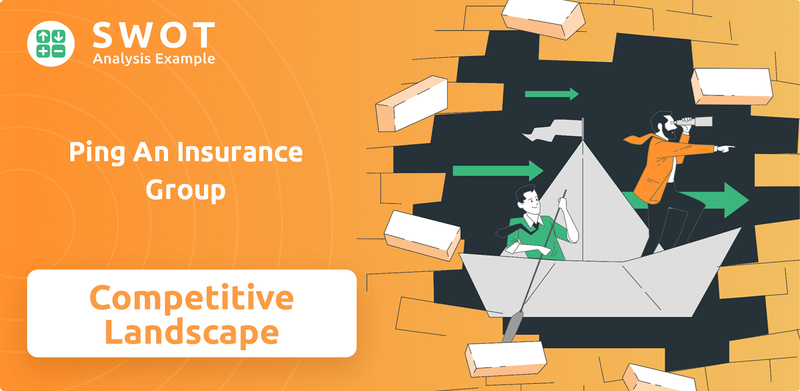
This Ping An Insurance Group SWOT Analysis will dissect its competitive landscape, exploring its market share and key rivals within the insurance industry analysis. We'll examine Ping An's financial performance and business strategy, comparing it to insurance competitors in China and globally. This deep dive will reveal Ping An's competitive advantages and how it maintains its market position amidst continuous innovation and digital transformation.
Where Does Ping An Insurance Group’ Stand in the Current Market?
Ping An Insurance Group holds a significant market position within China's financial industry. It has a diversified portfolio that extends its influence globally. The company is consistently ranked among the top insurers and financial service providers in China. Its primary operations include life and health insurance, property and casualty insurance, and banking services.
In 2023, Ping An's operating profit attributable to shareholders of the parent company rose by 11.7% year-on-year to RMB117,989 million. The life and health insurance business saw an operating profit attributable to shareholders of the parent company increase by 10.7% to RMB76,569 million. Ping An P&C achieved a net profit of RMB26,929 million in 2023. These figures highlight the company's financial strength and market leadership.
Ping An's strategic moves into digital financial services, such as Lufax Holding and Ping An Good Doctor, have diversified its offerings. This expansion allows Ping An to reach new customer segments, particularly those seeking online financial and healthcare solutions. This digital transformation is a key part of its strategy.
Ping An consistently ranks among the top insurers in China. Specific market share figures fluctuate, but the company is a major player in life and property & casualty insurance. Ping An often competes for the top positions with major rivals like China Life and PICC.
Ping An offers a wide range of financial products and services. These include life and health insurance, property and casualty insurance, banking services, and asset management. The diverse portfolio helps Ping An cater to a broad customer base and mitigate risks.
Ping An has invested heavily in digital financial services. Platforms like Lufax Holding and Ping An Good Doctor expand its reach. This move towards digital solutions enhances customer experience and operational efficiency.
Ping An maintains a robust financial position. The company's solvency ratio is well above regulatory requirements. This financial strength supports its ability to meet obligations and pursue future growth opportunities.
The competitive landscape for Ping An Insurance includes major players in the Chinese insurance market. Key rivals include China Life and PICC. These companies compete across various product lines and customer segments. Understanding these dynamics is crucial for assessing Ping An's market position.
- China Life: A major competitor in the life insurance segment.
- PICC: A strong player in property and casualty insurance.
- Other Insurers: Various other domestic and international insurance providers.
- Banking Sector: Competition from major banks offering financial services.
For more detailed insights into the business model and revenue streams, explore the Revenue Streams & Business Model of Ping An Insurance Group.
Ping An Insurance Group SWOT Analysis
- Complete SWOT Breakdown
- Fully Customizable
- Editable in Excel & Word
- Professional Formatting
- Investor-Ready Format
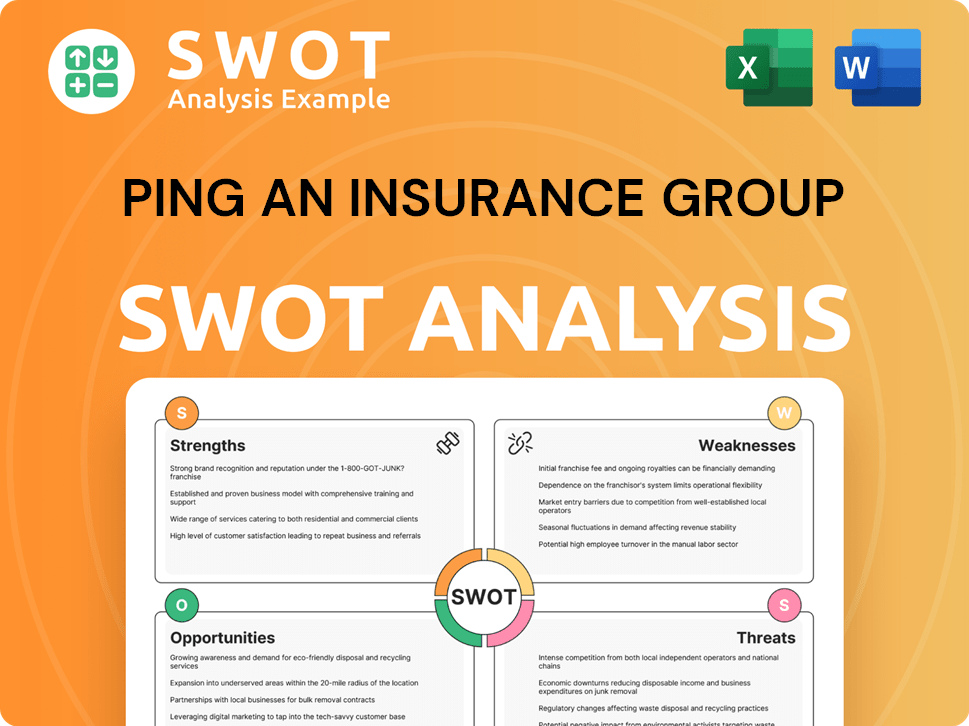
Who Are the Main Competitors Challenging Ping An Insurance Group?
The competitive landscape for Ping An Insurance Group is complex, encompassing a variety of players across different sectors. The company faces significant competition in life and health insurance, property and casualty insurance, banking, and fintech. Understanding these competitors is crucial for assessing Ping An's market position and strategic challenges.
The analysis of the competitive landscape requires a deep dive into each business segment to identify key rivals, their strengths, and their strategies. This includes evaluating market share, product offerings, distribution channels, and financial performance. Such an analysis helps in understanding the dynamics of the insurance industry and the broader financial services sector in China.
This article provides an overview of Ping An's main competitors, highlighting their key characteristics and the challenges they pose. For a deeper understanding of Ping An's growth strategies and market approach, consider exploring the Growth Strategy of Ping An Insurance Group.
In the life and health insurance sector, Ping An competes with major players like China Life Insurance Company, the largest life insurer in China. China Life is known for its extensive agent network and strong presence in lower-tier cities. China Pacific Insurance (CPIC) is another significant competitor, offering a broad product portfolio.
In property and casualty insurance, the People's Insurance Company of China (PICC) is a dominant force, especially in auto insurance. PICC often competes directly with Ping An P&C for market share. These competitors have a significant impact on the overall market dynamics.
In the banking sector, Ping An Bank competes with state-owned giants such as Industrial and Commercial Bank of China (ICBC), China Construction Bank (CCB), Agricultural Bank of China (ABC), and Bank of China (BOC). These banks have vast branch networks and significant corporate and retail client bases.
In the fintech and asset management space, Ping An faces competition from tech giants like Ant Group (Alipay) and Tencent (WeChat Pay). These companies offer a wide range of digital financial services, including payments, wealth management, and lending, leveraging their massive user bases.
The competitive environment is shaped by the size and scope of the competitors. State-owned banks challenge Ping An Bank through their scale and relationships. Fintech companies disrupt traditional models through technological prowess. Emerging players in specialized fintech niches also pose a challenge.
Market share data for 2024 indicates that China Life and PICC hold significant portions of the life and P&C insurance markets, respectively. Fintech adoption continues to rise, intensifying competition from digital platforms. Mergers and alliances within the industry could reshape competitive dynamics.
Several factors determine the competitive landscape for Ping An Insurance Group. These include market share, product offerings, distribution channels, and financial performance. Understanding these factors is crucial for analyzing Ping An's competitive advantages and disadvantages.
- Market Share: The percentage of the total market that a company controls.
- Product Offerings: The range and quality of insurance products and financial services offered.
- Distribution Channels: How products are sold, including agents, online platforms, and partnerships.
- Financial Performance: Key financial metrics such as revenue, profitability, and return on equity.
Ping An Insurance Group PESTLE Analysis
- Covers All 6 PESTLE Categories
- No Research Needed – Save Hours of Work
- Built by Experts, Trusted by Consultants
- Instant Download, Ready to Use
- 100% Editable, Fully Customizable
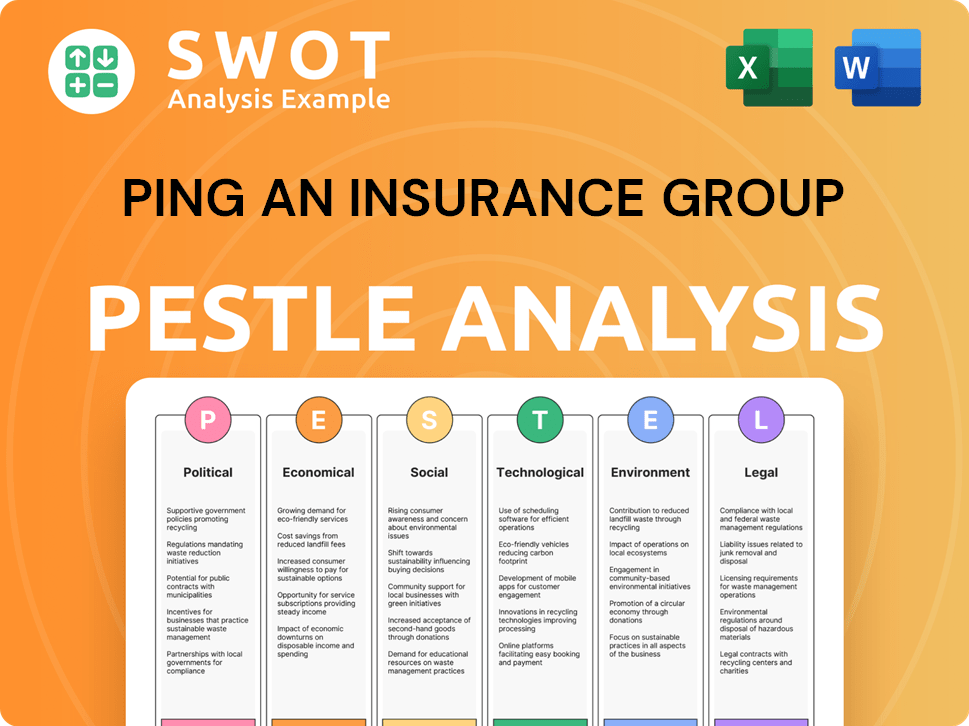
What Gives Ping An Insurance Group a Competitive Edge Over Its Rivals?
The competitive landscape for Ping An Insurance Group is shaped by its multifaceted advantages, which have solidified its position in the financial services sector. Its strategic diversification, technological advancements, and extensive ecosystem are key differentiators. A deep understanding of the Owners & Shareholders of Ping An Insurance Group provides insights into the company's strategic direction and competitive positioning.
Ping An's integrated financial services model is a significant competitive advantage. This 'one-stop shop' approach allows for cross-selling and synergistic operations across insurance, banking, asset management, and fintech. This integrated model enhances customer loyalty and provides a comprehensive view of customer needs, setting it apart from competitors with more siloed operations.
Proprietary technologies, particularly in AI, big data, and blockchain, form another crucial competitive edge. The company has invested heavily in R&D, leading to innovations in intelligent underwriting, claims processing, risk management, and personalized financial planning. Data analytics capabilities allow for more precise risk assessment and tailored product development.
Ping An's 'one-stop shop' model integrates insurance, banking, asset management, and fintech. This approach enhances customer loyalty and provides a comprehensive view of customer needs. This integration allows for cross-selling and synergistic operations.
The company's investments in AI, big data, and blockchain drive innovation. This includes intelligent underwriting, claims processing, and personalized financial planning. These technologies improve risk assessment and product development.
Ping An's strong brand recognition in China instills trust and attracts a large customer base. Its vast distribution network, encompassing agents, bancassurance, and digital channels, ensures wide market reach. This contributes to its competitive standing.
As one of the largest financial conglomerates, Ping An benefits from economies of scale. This enables cost efficiencies and greater investment in technology and talent. These advantages have evolved from its early focus on traditional insurance.
Ping An's competitive advantages are rooted in its integrated financial services, technological innovations, and strong brand. These factors collectively enhance its market position and customer engagement. The company's ability to leverage technology and its extensive ecosystem continues to drive its success.
- Integrated Financial Services: Cross-selling and synergistic operations across various financial sectors.
- Technological Prowess: Innovations in AI, big data, and blockchain for improved efficiency and customer experience.
- Brand Equity and Customer Loyalty: Strong brand recognition and a vast distribution network.
- Economies of Scale: Cost efficiencies and greater investment in technology and talent.
Ping An Insurance Group Business Model Canvas
- Complete 9-Block Business Model Canvas
- Effortlessly Communicate Your Business Strategy
- Investor-Ready BMC Format
- 100% Editable and Customizable
- Clear and Structured Layout
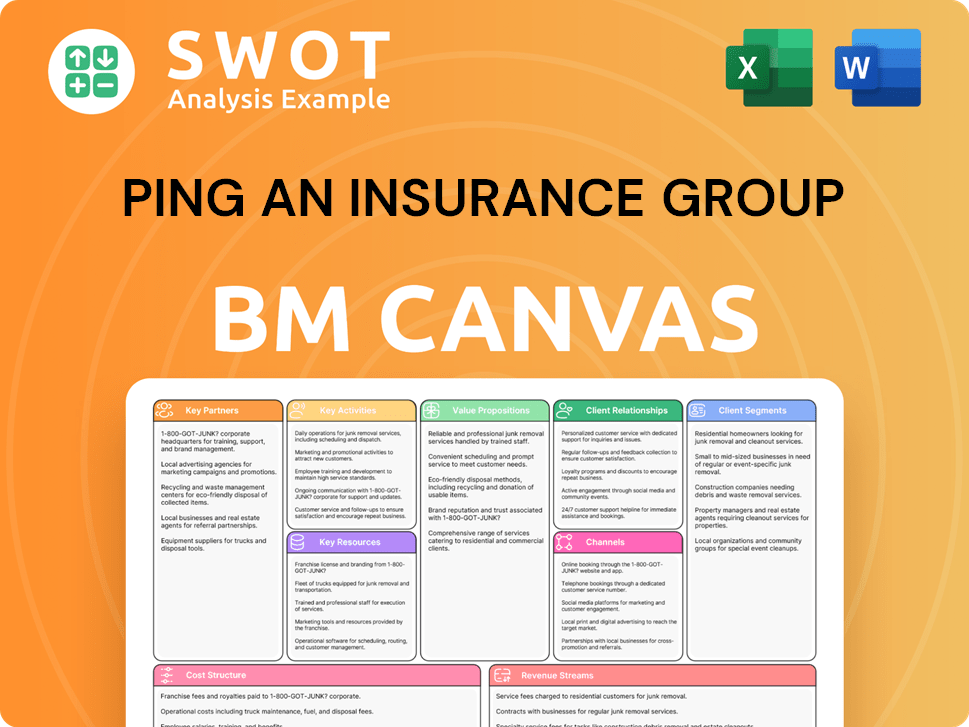
What Industry Trends Are Reshaping Ping An Insurance Group’s Competitive Landscape?
The Ping An Insurance Group operates within a dynamic financial services industry, facing both significant opportunities and considerable risks. The company's position is shaped by its ability to adapt to technological advancements, evolving regulatory landscapes, and shifting consumer preferences. A thorough insurance industry analysis reveals a competitive environment where innovation and strategic agility are critical for sustained success.
The competitive landscape for Ping An Insurance in China is multifaceted, with various players vying for market share. Understanding the current trends and potential challenges is crucial for assessing the future outlook and formulating effective strategies. This analysis considers key factors such as technological disruption, regulatory changes, and market dynamics to provide a comprehensive view.
Technological advancements, including AI and big data, are reshaping financial services. Regulatory changes, such as those impacting data privacy, influence operational strategies. Consumer demand for digital and personalized services drives the need for enhanced online presence.
Intensified competition from domestic and international players poses a threat. Technological disruption from agile startups could erode market share. Global economic uncertainties impact investment returns and consumer spending.
Expanding the 'finance + ecosystem' strategy, particularly in healthcare and smart city solutions, creates new revenue streams. Further penetration into lower-tier cities and strategic international expansion unlock growth. Developing green financial products aligns with rising ESG demands.
Continuous innovation and ecosystem expansion are vital for maintaining a strong market position. Robust risk management is essential to navigate a dynamic market. Adapting to changing consumer behaviors and preferences is critical.
Ping An's strategic focus includes leveraging technology to enhance efficiency. The company aims to expand its ecosystem, particularly in healthcare and smart city solutions. Risk management and innovation are crucial for long-term success.
- Market share Ping An needs to defend against both domestic and international competitors.
- Insurance competitors are increasing their digital offerings, intensifying competition.
- Ping An's competitive advantages include its strong technology platform and diversified business model.
- Ping An Insurance Group market share comparison shows the company's significant position in the Chinese market.
For a deeper dive into the financial performance and strategic initiatives of Ping An Insurance Group, consider reading a comprehensive analysis of its business strategy.
Ping An Insurance Group Porter's Five Forces Analysis
- Covers All 5 Competitive Forces in Detail
- Structured for Consultants, Students, and Founders
- 100% Editable in Microsoft Word & Excel
- Instant Digital Download – Use Immediately
- Compatible with Mac & PC – Fully Unlocked
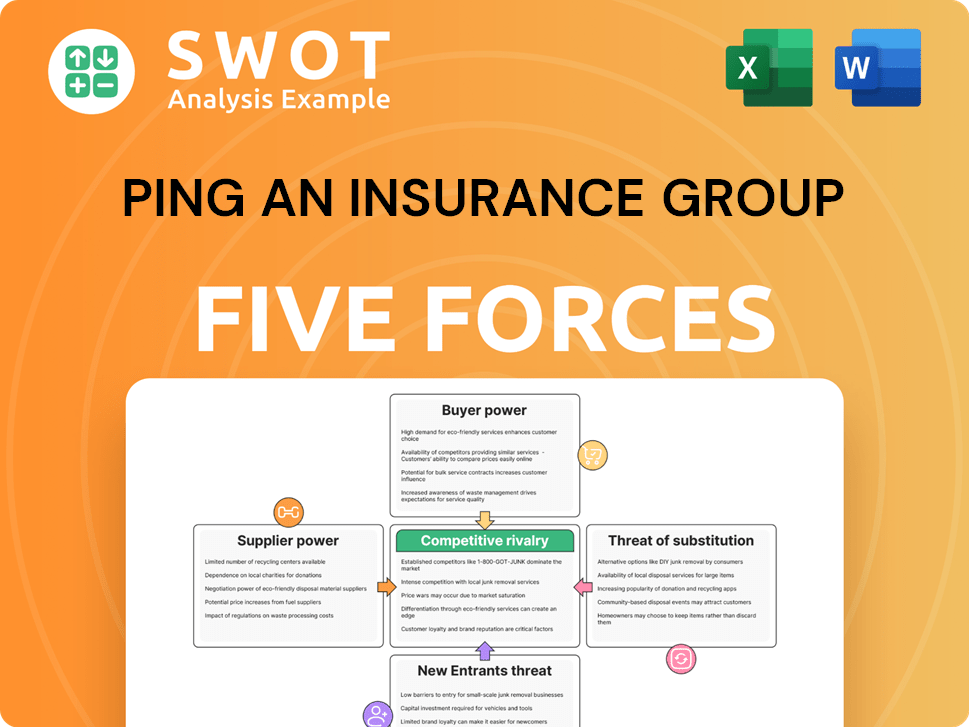
Related Blogs
- What are Mission Vision & Core Values of Ping An Insurance Group Company?
- What is Growth Strategy and Future Prospects of Ping An Insurance Group Company?
- How Does Ping An Insurance Group Company Work?
- What is Sales and Marketing Strategy of Ping An Insurance Group Company?
- What is Brief History of Ping An Insurance Group Company?
- Who Owns Ping An Insurance Group Company?
- What is Customer Demographics and Target Market of Ping An Insurance Group Company?
Disclaimer
All information, articles, and product details provided on this website are for general informational and educational purposes only. We do not claim any ownership over, nor do we intend to infringe upon, any trademarks, copyrights, logos, brand names, or other intellectual property mentioned or depicted on this site. Such intellectual property remains the property of its respective owners, and any references here are made solely for identification or informational purposes, without implying any affiliation, endorsement, or partnership.
We make no representations or warranties, express or implied, regarding the accuracy, completeness, or suitability of any content or products presented. Nothing on this website should be construed as legal, tax, investment, financial, medical, or other professional advice. In addition, no part of this site—including articles or product references—constitutes a solicitation, recommendation, endorsement, advertisement, or offer to buy or sell any securities, franchises, or other financial instruments, particularly in jurisdictions where such activity would be unlawful.
All content is of a general nature and may not address the specific circumstances of any individual or entity. It is not a substitute for professional advice or services. Any actions you take based on the information provided here are strictly at your own risk. You accept full responsibility for any decisions or outcomes arising from your use of this website and agree to release us from any liability in connection with your use of, or reliance upon, the content or products found herein.